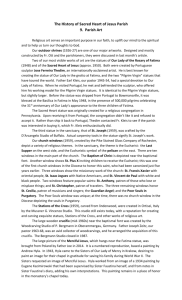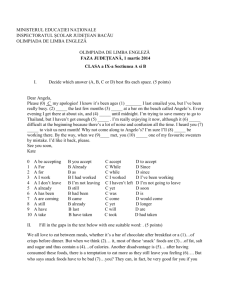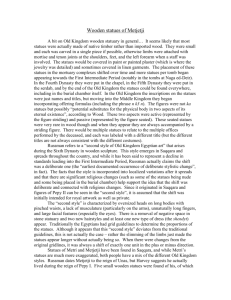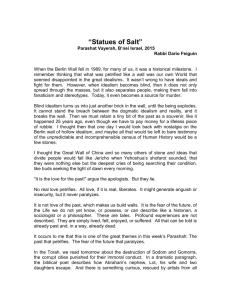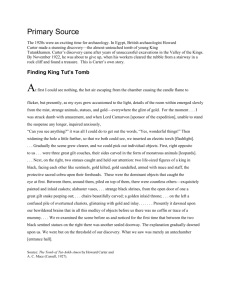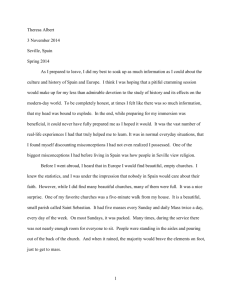here - WordPress.com
advertisement
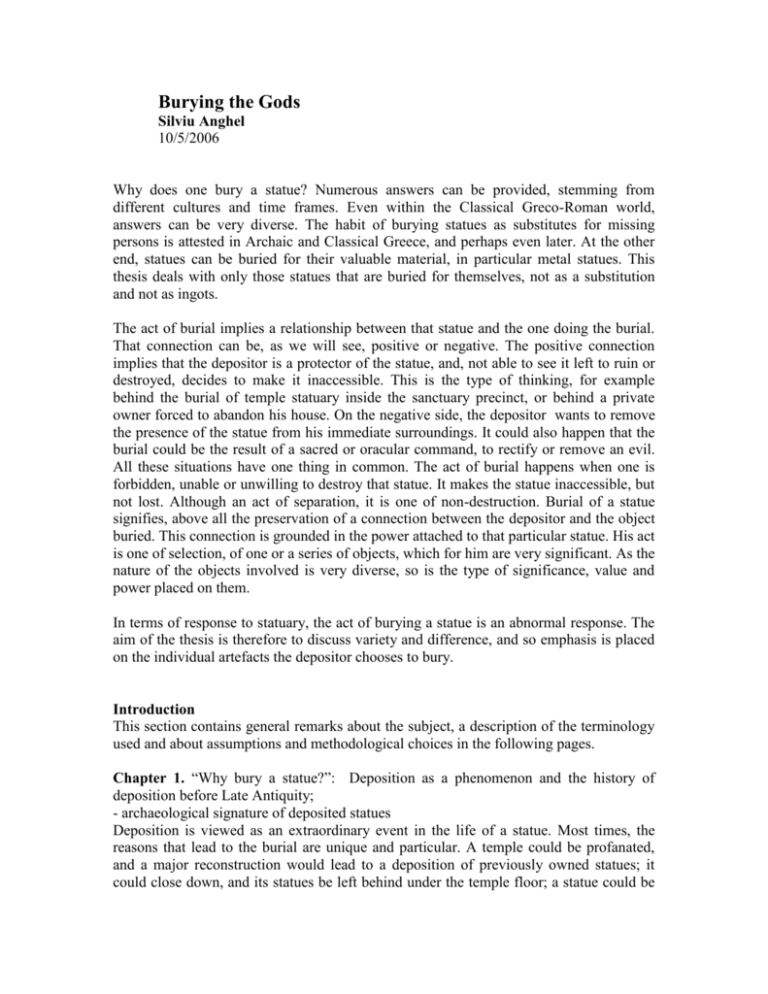
Burying the Gods Silviu Anghel 10/5/2006 Why does one bury a statue? Numerous answers can be provided, stemming from different cultures and time frames. Even within the Classical Greco-Roman world, answers can be very diverse. The habit of burying statues as substitutes for missing persons is attested in Archaic and Classical Greece, and perhaps even later. At the other end, statues can be buried for their valuable material, in particular metal statues. This thesis deals with only those statues that are buried for themselves, not as a substitution and not as ingots. The act of burial implies a relationship between that statue and the one doing the burial. That connection can be, as we will see, positive or negative. The positive connection implies that the depositor is a protector of the statue, and, not able to see it left to ruin or destroyed, decides to make it inaccessible. This is the type of thinking, for example behind the burial of temple statuary inside the sanctuary precinct, or behind a private owner forced to abandon his house. On the negative side, the depositor wants to remove the presence of the statue from his immediate surroundings. It could also happen that the burial could be the result of a sacred or oracular command, to rectify or remove an evil. All these situations have one thing in common. The act of burial happens when one is forbidden, unable or unwilling to destroy that statue. It makes the statue inaccessible, but not lost. Although an act of separation, it is one of non-destruction. Burial of a statue signifies, above all the preservation of a connection between the depositor and the object buried. This connection is grounded in the power attached to that particular statue. His act is one of selection, of one or a series of objects, which for him are very significant. As the nature of the objects involved is very diverse, so is the type of significance, value and power placed on them. In terms of response to statuary, the act of burying a statue is an abnormal response. The aim of the thesis is therefore to discuss variety and difference, and so emphasis is placed on the individual artefacts the depositor chooses to bury. Introduction This section contains general remarks about the subject, a description of the terminology used and about assumptions and methodological choices in the following pages. Chapter 1. “Why bury a statue?”: Deposition as a phenomenon and the history of deposition before Late Antiquity; - archaeological signature of deposited statues Deposition is viewed as an extraordinary event in the life of a statue. Most times, the reasons that lead to the burial are unique and particular. A temple could be profanated, and a major reconstruction would lead to a deposition of previously owned statues; it could close down, and its statues be left behind under the temple floor; a statue could be deposited after it accidentally fell off its base, or was hit by lightning. It could happen that an impending danger led to the hiding of the statues. The reasons for each deposition have to be analyzed in turn, based on a combined study of the location of the deposition and its signature, the associative material and the contents of the cache. The reasons for deposition vary from case to case. Most of them, however, are extraordinary events in the life of a statue or its surroundings. The destruction of the temples of Gebel Barkal or Kerma led to the fragmentation and deposition of some of its statues. The threat of Persian invasion led to the hiding of several kouroi in Attica. A statue of Hercules Mastai was buried after it was hit by lightning. Only a few depositions are the result of an acquired tradition of clearance of sacred precincts of old ex-votos, to make space for new ones. This is the case, for example with the greatest deposition of statues in Antiquity, from the temple of Karnak. Chapter 2. Statue deposition in LA Statue depositions are presented grouped according to their location. This is based on the assumption that depositions usually occur near to the lace where they had been previously housed. A discussion of the diffenent discernable scenarios behind depositions follows: a. Burying statues in Late Antiquity: tradition and innovation b. Cases that conform to earlier practice - case of Artemis of Ephesus, Walbrook Mithraeum, Douch or Hama; Roma the Monte Martini mithraeum. c. New cases: a different archaeological signature and it’s interpretation / the bulk of the cases: Carthage, Sidi Bishir d. Unclear cases e. New reasons for burying statues [In addition to an understood continuation of the previous practice of irreversible abandonment, there are cases in which this signature is not present, yet care for protection is still taken.] - abandonment. Statues continue to be abandoned as before, with the same archaeological signature, but they are a lot more diverse. Many private statues are buried (very little before), in particular statuary collections from private villas, with a composite mixed, are abandoned. - hiding statues from Christian fundamentalism– very clear only in the case of evidence for impending destruction. Christian indirect influence may have existed in other cases, but it is not discernable. - storage. In the case of privately owned statuary buried in underground rooms, which are then sealed up, care is taken to protect them, but there is no evidence that the statues are intended not to be found again. There is no sign of irreversibility: Carthage, Sidi Bishir, Sidon, Adam. - magical (term used for lack of something better) reasons ? – literary evidence but very hard to match archaeologically Chapter 3. Christians and statue deposition There has been a lot of recent literature on the Christian destruction of statues in LA. Most sources for destruction are literary, and therefore late. There is evidence for a lot of archeological destruction of statues, but it is hard to see behind it. Some was religiously motivated, but even within this category, there is very little that can be dated to the early centuries of Christian presence. In particular, there is almost no archeological evidence for the destruction of an active pagan place. For example, the Serapeion in Alexandria was destroyed by Christians. Archeologically we have evidence for a thorough destruction of the site, but was it all, or part of, religiously motivated, and if so, when was it done? Returning to deposition, which statues were in fact hidden in face of imminent Christian intervention? No single statue can give a positive answer, but the overall catalogue of statues is evidence for some changes, some of which could be attributed to the rise of Christianity. Chapter 4. “Why keep statues?” By far the most substantive part of the thesis. The starting point (now) is the observation that most (though not all) of the buried statues belonged to private parties (be them religious or not). This highlights the value of the corpus in the non-public part of society in LA. It provides a unique opportunity to contextualize the depositions. The aim is a description of those who keep statues in LA. How does the habit of keeping statues change? What people would persist in keeping statues throughout the Christian threat and why? Where do they the statues – temples, former private collections, etc? What interests do these statues show? Do they show a transition in religious ‘pagan’ habits? The chapter fluctuates between change and persistence in LA. Ultimately it should lead to a picture of who hid statues in LA, with issues of social, cultural and religious history. Statues originating from sanctuaries are deposited in LA, but the vast majority of cases connected with the closing of temples. Finally, a small number of statues previously housed in public buildings, such as baths or theaters, are discussed. Chapter 5. Catalog Caches are presented in geographical order, to complement the thematic grouping of chapter 2. A list, short description and bibliography are provided for each case, together with a brief analysis of their archeological signature.

